Sparkplug to Bucephalus: Horses
“Though horses started disappearing from America’s roads and fields about a century ago, Pegasus and Winnie are still kicking up their heels in English prose, poetry, and speech. Indeed, after studying the impact of horses on the language today, one might think they’d never gone to pasture. In a sense, they never did because most Americans will understand my equine reference whether they think the Four Horsemen of the Apocalypse played for Notre Dame or Satan.”—Skip Eisiminger
Skip the B.S.
By Dr. Skip Eisiminger
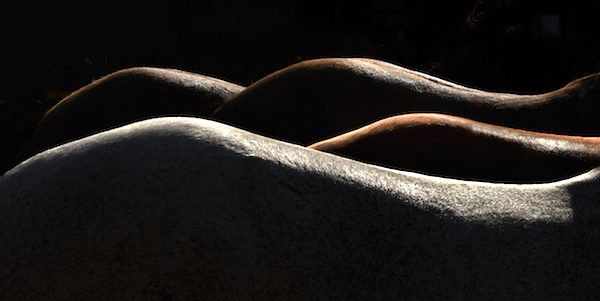
I. “When I bestride him, I soar. I am a hawk; he trots the air. The earth sings when he touches it; the basest horn of his hoof is more musical than the pipe of Hermes.”―William Shakespeare
CLEMSON South Carolina—(Weekly Hubris)—February 2021—The Emperor Caligula apparently was deaf to the music Shakespeare heard because he had his horses shod in gold to silence the sound that has quickened the beat of innumerable hearts, be the rider rival or lover. It’s a safe bet Caligula overlooked many equine virtues, towed as he was in a vault behind a team of Equus caballi. What follows is some of what the tone-deaf emperor might have missed.
The “odd-toed ungulate” possesses the largest eye of any land animal, giving it a 350° range of vision without moving its head. Thanks to its side-mounted, protuberant eyes, horses see better than humans do in the dark though they cannot distinguish red. And given their large, flaring nostrils, they can usually detect which of the vet’s “treats” has been dosed with medicine. Zoologists tell us that the hearing of this charismatic megafauna is acute, thanks to the fact that each ear can rotate 180°, which means every approach a predator might take is covered. And what they hear affects their entire body: domesticated horses stabled in barns where rap, jazz, rock, and talk radio are played are more likely to develop ulcers than horses stabled where Mozart is on the playlist. And on that musical note, let me add that hair from a horse’s tail is often used to string a violin’s bow.
Even when its head is down and grazing for as long as ten hours a day, the horse is on full alert. When the herd is resting, whether lying down or standing, one horse is the designated sentinel. When grazing, a horse’s prehensile lips enable it to sort good grains from the noxious. And because it can only breathe through its nostrils, it can graze all day without fear of choking or vomiting. However, if allowed near a grain-storage bin, horses like sheep have been known to eat themselves to death; thus, the expression, “Eat like a horse.”
Given that a horse’s basketball-size heart allows it to gallop for two miles at a top speed of 55 mph, it’s no wonder that Shakespeare compared the rider above to a hawk because at times his mount has all four feet off the ground. When not “soaring,” it can canter for five miles or trot for 20. We say “work like a horse” because its endurance is legendary; some Arabians have been known to cover 100 miles in 24 hours. Though the average weight of a horse is a little over 1,000 pounds, its longest jump was over 27’; its highest jump was over 8’, both very close to the records for American males, whose average weight is about 180 pounds. Depending on the breed, a horse’s size may range from Sampson, 7’ 2” at 3,360 pounds, to Einstein, who at birth was 1’ 2” and weighed 6 pounds yet was not a dwarf. Most horses can expect to live about 25 years, but Old Billy lived 62. Upon his death, his equine companions visibly mourned their loss. Small wonder that the oldest sculpture known to us is that of a horse carved 31,000 years ago, a time when horses were mostly appreciated for their meat.
While our appreciation of Equus has increased over the roughly six millennia we have been riding on its back, we still slaughter about five million of them a year to feed ourselves and our carnivorous pets. Most have forgotten or never knew that there was a stud book for horses 35 years before Burke’s Peerage, a “stud book” for aristocrats that was published in 1826, and the first SPCA was formed in 1824, long before there was a similar agency to protect children.
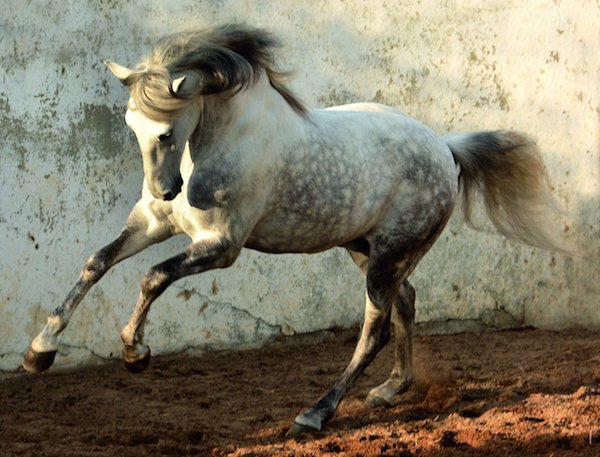
II. “There is nothing better for the inside of a man than the outside of a horse.”—Winston Churchill
While I would have concluded Churchill’s memorable observation with the word “woman,” few animals have done more for mankind’s rise to the top of the food chain than the horse. Thanks to an asteroid strike sixty-six million years ago that eliminated the dinosaurs, rat-sized mammals suddenly found the playing field open. Over the next ten million years, Eohippus, the “dawn horse,” evolved from the “archaic ungulates” that eventually gave us the family of hooved mammals that also included deer, cows, and pigs.
Dating back some sixty million years, the earliest signs of Eohippus have been found in the Americas. For some reason, probably grazing opportunities, the descendants of this dog-sized ur-horse, Orohippus, Mesohippus, and others, left the Americas via the Bering Sea land bridge and crossed into Asia. From there, these animals spread to Africa, where the rhinoceros and zebra evolved, and India, where the cow and ox evolved. The European horse was so prized as a source of protein by Neanderthal and Cro-Magnon hunters that it became the most painted animal in the caves of Spain and France. Indeed, it was so popular it was nearly hunted to extinction, but when some Indo-Europeans finally managed to ride one about 4,000 BC, its fate was sealed: it would no longer mainly be eaten but used to export Indo-European warriors, their trade goods, and the language they spoke.
Taking the horse full circle, the Spanish reintroduced the horse to the Americas in the 16th century when 16 men astride their horses subdued an Aztec population of perhaps a million. The Aztecs believed these “centaurs” were semi-divines clad in silver whose arms issued fire and lead. However, the Spanish often abused the animals who’d helped them subdue an empire by blinding those designated for work in the silver mines and dumping them in the Atlantic when they were becalmed in the doldrums.
As the horse migrated into North America and was adopted by tribes like the Comanche, tribal leaders like one old Cheyenne priest said, “If you have horses, everything will be changed.” The priest foresaw the upheaval that lay ahead if the relatively stable agrarian economy the tribe had enjoyed for centuries reverted to a hunter-gatherer economy mounted on horses. He was, of course, correct, for horses make better farm animals than war horses facing machine guns and tanks. In the American Civil War, 1.5 million mules and horses died or were killed; in World War One, of the one million American horses sent to the war, only 200 returned. On all sides in that war, 8 million horses were lost. In World War Two, 1.8 million more were lost.
Despite the war losses, the introduction of the internal combustion engine was what really signaled the horses’ radical decline. In the 50 years after 1915, the US horse population dropped 90 percent as tractors and trucks hauled off the 1,100 tons of manure that horses left on the streets of New York each day. In an ironic effort to reverse the “dehorsification” of North America, dog-food producers like Ken-L-Ration raised 50,000 horses a year in the 1930s to be slaughtered for dog food. And while the Nazis had failed in their attempt to reintroduce the “Aryan” tarpan for Hitler to hunt, others were having more luck breeding horses with zebras to create the zorse.
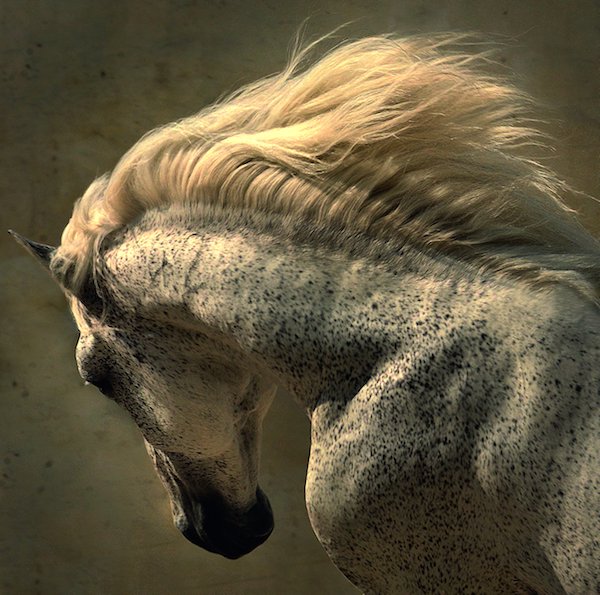
III. There is no better place to heal a broken heart than on the back of a horse.”―Missy Lyons
Though horses started disappearing from America’s roads and fields about a century ago, Pegasus and Winnie are still kicking up their heels in English prose, poetry, and speech. Indeed, after studying the impact of horses on the language today, one might think they’d never gone to pasture. In a sense, they never did because most Americans will understand my equine reference whether they think the Four Horsemen of the Apocalypse played for Notre Dame or Satan.
Someone said that the reason Americans prefer beef to horse flesh is that there are no cows named Black Beauty or Flicka, and as my whimsical title to this essay suggests, the terms we have created for our horses harness many of the contrasts and dualisms in our culture. Consider the connotations of the following pairings:
- “steed” and “nag”
- “stud” and “gelding”
- “stallion” and “brood mare”
- “chestnut” and “pinto”
- “steeplechaser” and “draft horse”
- “thoroughbred” and “crowbait”
- “War Admiral” and “Rocinante”
- “show horse” and “pack horse”
- “war horse” and “cayuse”
- “sawhorse” and “horse” (slang for heroin)
Indeed, horses are often at the forefront of the world’s religious and cultural contradictions. In Arab countries, Muslims believe that Allah admitted Balaam’s ass to heaven but not a single Arabian courser. Noah’s dove made it, but the donkey, the horse’s close relative that Jesus rode into Jerusalem, was excluded. In India, Hindus allow all castes to celebrate weddings, but the Dalit groom is forbidden from riding a horse to his own wedding, for that would be putting on airs he does not deserve.
But no one was putting on airs a few years ago when I volunteered to help chaperone about 15 children living with ADHD to a horse-therapy farm. On the 30-minute bus ride to the farm, the kids were loud and agitated, but once we volunteers got our charges in their saddles and started leading them around the barn, the horses seemed to exude a comportment that becalmed everyone from rider to groom.
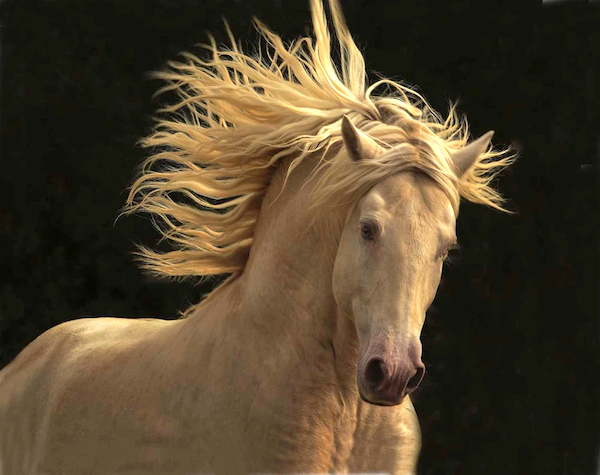
IV. “The lack of communication with horses has impeded human progress . . . . If we ever broke down the barriers, we could produce the centaur.”―Gabriel Garcia Marquez
My wife, Ingrid, was never one of those “horsey girls,” in Jane Smiley’s words, who discover “in the end . . . that boyfriends, husbands, children, and careers are the substitute for horses.” But of all the members of my family, it is she who grew up with the perpetual but not unpleasant odor of horses, or as Jonathan Swift called them, “the Houyhnhnms.” Her family in the northern German village of Wolsdorf (pop. c. 500) never owned a horse, but on the farms that surrounded her home, the animals were ubiquitous. Like many children, she grew up with some misgivings about those huge creatures after learning that her paternal grandfather had been killed by a team of runaway horses, and her younger brother had been kicked trying to steal some manure for his mother’s garden.
One of Ingrid’s earliest memories is that of a horse-drawn sleigh pulled by two horses taking some farmer’s children to meet a train in the snow. When the snow melted, the same team pulled a wheeled carriage and its young passengers to the local station, where they caught a train to school. While walking those two miles to the station, she was often passed by the jingling bells of those capacious vehicles, but the Yahoo driver seldom stopped for her or her schoolmates.
The few times she was offered a ride, it was on a crude horse-drawn wagon taking about ten children to the local potato fields to collect the destructive beetles dropped from Allied bombers. At least, that’s the lie she was told.
The only time Ingrid has ridden a horse was at my Uncle Bill’s farm, where my cousin Helen managed to convince her guest to ride Thunder. Why Helen thought that skittish mount was appropriate, I do not know, but it may have been the convincing whicker Ingrid uttered when Helen suggested a ride. No sooner had Ingrid seated herself on an English saddle than she dropped one rein. Pulling on one rein just sent Thunder into a frenzy trying to bite Ingrid’s leg while running in smaller and smaller circles. After that dizzy ride, I couldn’t even get her on a merry-go-round.
Perhaps it was the horse meat she ate as a child or the Premarin she took in menopause, but one thing that she learned from horses was the pitch and rhythm of their whinny and neigh. She’s always been something of a mimic, but her horse imitation often astonishes those who hear it. Indeed, it astonishes the horses who hear it. Once, near her brother’s home in heavy traffic, we drove up beside a car pulling a horse trailer. At my urging, Ingrid rolled her window down and whinnied. To our surprise, the horse whinnied back and began kicking the metal sides of its trailer. She has no idea what she communicated to that poor beast, but it sure was excited, and so was its owner.
Once, walking along a country road in the North Carolina mountains, we came upon three horses in a tree-locked pasture much like the pastoral setting of “A Blessing,” by James Wright. Though the animals were about 50 yards away and, I thought, well out of Ingrid’s range, she whinnied smartly, and one of the three broke into a thunderous gallop as he raced toward us. I’m happy to report that the fence that separated us was “pig tight, bull strong, and horse high,” as my grandfather used to say, but that’s the last time I’ve asked her to whinny in the vicinity of a live horse. At tense moments like that one, Ingrid likes to remind me that, in many wild herds, a mare is dominant.
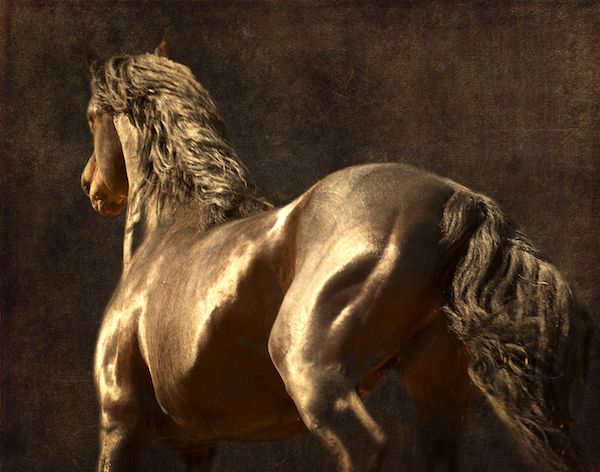
V. “Here [in the Hebrides] I first mounted a little Highland steed; and if there had been many spectators, [they] should have been somewhat ashamed of my figure in the march. The horses of the Islands, as of other barren countries, are very low: they are indeed musculous . . . , beyond what their size gives reason for expecting; but a bulky man [like me] upon one of their backs makes a very disproportionate appearance.”—Samuel Johnson
As a lanky adolescent whose feet dragged the ground astride my grandfather’s pony, I must have made a similar Johnsonian impression. Over the 50 years I knew him, Papa, as we called him, owned several horses because, as he said, they reminded him of the time when he’d courted his future wife in a horse-drawn buggy. In 1912, the same year the number of automobiles in New York City surpassed that of horses, Papa made a trip to the Big Apple where he enjoyed going up- and downtown in a streetcar pulled by a team of Clydesdales. What he did not know is that the tide of equine effluvium was projected to reach the third floor of Manhattan’s finest buildings in fewer than 20 years. The automobile, of course, prevented that. Back in South Georgia with a car in his newly built garage, Papa was never without a few sugar cubes in the glove compartment.
After riding any of Papa’s horses, the rider was handed a curry comb, a hog-bristle brush, and given instructions on how to use them. It was during one of these grooming sessions that Papa told me how to steal a horse. “It’s very easy,” he said, “because horses are suckers for sweets. All you have to do is go to the livestock barn at the county fair, and when no one is looking, feed the horse you fancy some sugary treat while cupping your face to its nostrils. Once it’s gotten a lung full of your scent, you can return at night, break into the barn, feed the horse some more sugar after you let him have another whiff of you, and walk right out leading him without any complaint. But remember,” he said, “No foot, no horse, so be sure to examine the condition of the hooves as well as the teeth.” As useful as this advice is, I’ve never had occasion to use it.
I haven’t ridden a horse in many years, but one I saw recently made a lasting impression. My family and I were visiting Arlington National Cemetery on the occasion of my father’s funeral. As we gathered by the empty grave, we heard the clatter of horses coming from over the ridge behind us. Looking over my shoulder, I saw two black horses pulling a black wagon with a black casket secured to the floor. Following the wagon, a very spirited but riderless, black horse was being led by a spit-shined soldier. The three-gun salute, the playing of “Taps,” the presentation of the flag, nothing stirred me more than that magnificent stallion with a pair of boots lodged in the stirrups—the boots of the fallen soldier, a custom that dates to the 13th century and the funeral of Genghis Khan, where a horse was sacrificed to serve the fallen warrior in the next world.
Regardless of the needs in the afterlife, it’s best we that we have outgrown some of our traditions.

About the Images Used to Illustrate This Essay:
Writes equine photographer Tony Stromberg: “After successfully spending over 20 years as a high-end advertising photographer in San Francisco, I found myself disenchanted, burned out, and ultimately receiving no nourishment from the work I was doing. On the outside, I had everything anyone would want, but my inner landscape was barren, and I began “searching” for my lost spirit. When horses came into my life in the mid-1990s, I realized that I had found my teachers, and the connection that I have developed with horses has helped steer my life in a completely different direction. Horses have taught me so much in the time that I have spent with them. They have taught me about the power of authenticity, honestly, and integrity, and they have taught me the true meaning of leadership and relationship. They have also taught me about living in collaboration and community, rather than the model that our society embodies, which is about competition and “getting ahead of the rest. I feel my work is an homage to the equine spirit, and to the archetypal role they play in our lives. This is why I always photograph them without riders, saddles, bits, bridles or any other device that would interfere with their pure essence.” Find Stromberg’s four books, Horses, The Forgotten Horse, Spirit Horses and Horse Medicine here.

To order copies of Skip Eisiminger’s Letters to the Grandchildren (Clemson University Digital Press), click on the book cover below or contact: Center for Electronic and Digital Publishing, Strode Tower, Box 340522, Clemson SC 29634-0522. For Wordspinner: Mind-Boggling Games for Word Lovers, click on the book cover.




2 Comments
Jean
Skip, what a delicious and informative treatise on one of my favorite subjects. Remarkable creatures, and frequently so kind. My grandfather, in northern Wisconsin, had a team of Belgians, with whom, in spring, he plowed, and in winter, cut ice, back in the 20s and 30s. Horses, too, built this country. Thank you – and, yeah, Ingrid clearly shouldn’t do her whinny. It’s like an inflected language, lord knows what she’s saying!
Skip Eisiminger
Thanks, Jean–glad you liked it.
I just returned from a bike ride, part of which runs alongside a large pasture where three horses live. Usually they just browse and ignore my Good-Humor bell. Today, however, they thundered past me and disappeared into some dark woods.
I guess they were just enjoying the 60 degree temperatures .
Skip